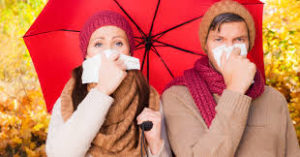Autumn brings on more than just falling leaves and dropping temperatures. The change of seasons from summer to fall also brings changes to your health.
The cold weather can suppress your immune system — increasing your susceptibility to infections, according to Harvard Medical School.
But other factors, such as poor preparation, also share the blame for the spread of these infections.
“To avoid these illnesses, seeing your physician early if flu symptoms arise can shorten the duration of the disease because of anti-viral medications,” said Dr. Johnson. “Good hand washing is important to decrease transmission of viruses. Most importantly, getting the flu vaccine is strongly recommended.”
Hand washing is the first step to preventing infection and infection spread!
As the season change, checking the forecast and always dress appropriately can help prevent illnesses. Die-hard fans of shorts and T-shirts increase their risk of getting sick if they continue to dress for summer well into fall, according to the U.S. Centers for Disease Control and Prevention.
Preventing other fall conditions — like seasonal affective disorder and Raynaud’s phenomenon — might not be as easy, but preparation is still important.
5 Common Illnesses that develop in the fall &/or winter:
1. Seasonal Flu
According to the U.S. Department of Health & Human Services, fall’s kickoff sparks the onset of flu season, beginning in the autumn months and stretching into as late as May.
The flu typically peaks in January and February during the brunt of winter.
A respiratory illness, the flu spreads from person to person, mostly through coughs, sneezes and even general talking. It is possible to contract the flu by touching a surface infected with the flu virus then transmitting it to your mouth, nose or eyes.
Up to 20 percent of the population will be impacted by the flu each year.
2. Common Cold
Common colds can affect anyone at any time of the year, but peak cold activity hits during the winter and rainy months, according to the University of Maryland Medical Center (UMMC). There are over 1 billion colds reported in the United States throughout each year.
An upper respiratory infection, colds are spread similarly to the flu. Colds ordinarily bring nasal congestion, scratchy throats and sneezing along with other symptoms depending on the strain.
3. Norovirus
As the most common stomach inflammation illness in the United States, commonly referred to as the stomach flu, norovirus reaches its highest strength during the winter months.
An extremely contagious virus, norovirus is the cause of up to 21 million illnesses each year, according to U.S. Centers for Disease Control and Prevention. Outbreaks spread from person to person, most commonly in long-term care facilities.
4. Acute Ear Infections
Ear infections, especially in children, are more likely to occur in winter than any other season, according to UMMC. Changes in climate, especially as colder air takes hold, will enhance the threat of an acute ear infection.
UMMC also says that ear infections are the number one reason parents take their children to the doctor. Symptoms of general ear pain and even nausea can be the most disruptive symptoms.
5. Bronchitis
A virus that impacts children, mostly under the age of two, bronchiolitis is a swelling and mucus buildup within the smallest lung air passages, according to UMMC.
The virus peaks in the fall and winter months. It most commonly is caused by a viral infection and is spread from person to person when coming in direct contact with nose and throat fluids of someone carrying the virus.
The CDC and UMMC recommends to wash hands frequently as the easiest way to prevent the spread of any of the illnesses. Disinfect counter tops, door knobs and other frequently touched surfaces often.
Dress properly for the fall and winter with taking further action with the flu and pneumonia vaccines by going to your primary doctor and finding out which vaccines are appropriate for you. Also take action and get treatment for any illness listed above with having a doctor care for you in treating the virus or bacteria or simple cold you have. The only way to find out is to be assessed by your doctor who will tell you what you have.

